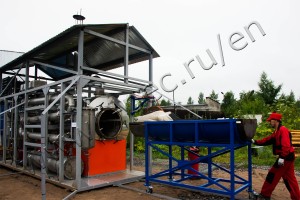Pyrolysis from A to Z (part 2)
Waste processing technologies and plants
Pyrolysis process is conducted in dedicated heating equipment. It has 2 main areas where 2 stages of the process are carried out. The pyrolysis is divided to radiation and convection. The pyrolysis itself is conducted in radiant part of the equipment, dehydration, final decomposition and condensation is carried out in convection part. Depending on feedstock composition pyrolysis plants differ in their radiant part.
For the processing of oil products the coils (tube chamber) are used, for solid waste treatment the open reactors can be used. Differences in design are reflected in the heating system that requires controlled increasing of the temperature in reaction zone. The design also must ensure the shortest possible feedstock exposure to the heat that must not exceed 0,1-0,5 sec.
Today our modern development of waste recycling technologies emerged on number of thermal pyrolysis or thermal decomposition plants, which are fully automated and easy in maintenance, for example, Batch Thermal Decomposition Plant (UTD-1).
Pyrolysis as a conversion process
Let us consider pyrolysis as a process of thermal decomposition of carbon based materials served as a feedstock (input). Its main products are mixture of gaseous products, liquid oil products and solids (carbon black and any metals or minerals that might have been components of the feedstock). The process is outlined as following:
- Feeding the raw materials to the reactor;
- Heating in the oxygen free conditions by the burner, the temperature in the reactor is controlled and smoothly increased;
- Start of the thermal decomposition, pressure rise signals the beginning of the reaction;
- Stabilization of the process, burner is switched to the pyrolysis gas;
- Primary separation in heat exchanger where condensate is accumulated in the receiver tank;
- Deep separation phase in gas-liquid separator to liquid and gas fractions;
- The product is drained to storage tanks;
- Dry residue rests in the chamber and is removed after cooling.
The main equipment is: reactor, heat exchanger, separator and tanks. Cooling is carried out by water and air cooling system, the burner uses both liquid fuel and gas.
Thermal Decomposition Process of UTD -1 (watch the video)
Usage of the products of pyrolysis
The process of pyrolysis produces unsaturated hydrocarbons, such as ethylene, propylene, butadiene and other alkanes. They are used in production of plastics, rubber and other synthetic materials. In relation to the capabilities of thermal decomposition plants the products are:
- Pyrolysis gas, which is used at the plant for heating;
- Coke residue (carbon black) of hazard class 4-5, used in construction, also can be added to the coal bricks;
- Synthetic oil, can be utilized in boilers or refined to renewable diesel oil;
- Heat of the plant is used for local heating;
- Distilled water (in case of brine based drilling sludge) is used locally.
Advantages of pyrolysis:
- Alternative energy recovery;
- Full control over the process;
- High energy efficiency because of usage of self-produced fuel;
- Negligible emissions;
- Transformation of no-cost feedstock into a valuable commodity;
- Wide range of usage of the products – waste treatment, energy recovery, commodity chemical elements;
- Cost – efficient process for drilling waste, scrap plastics and resin-based products.
When using the material or any part of it the link to the website (www.i-pec.ru) is required

